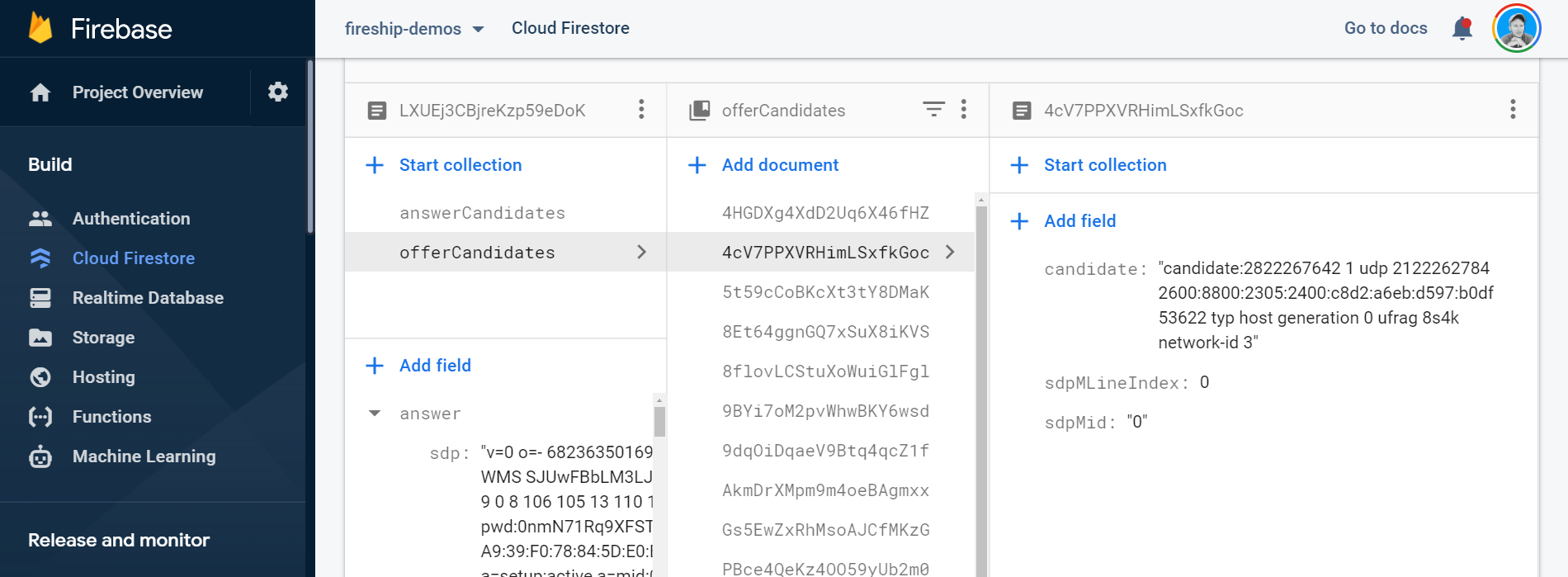Build a Zoom-like video chat app using WebRTC and Firebase 859 words.
Last Updated
WebRTC facilities realtime audio/video communication on the web using a peer-to-peer protocol, allowing you to build apps like Zoom, Skype, etc.
The following lesson builds a 1-to-1 video chat, where each peer streams directly to the other peer - there is no need for a middle-man server to handle video content. However, a 3rd party server is required for signaling that stores shared data for stream negotiation. Firestore is an excellent choice for WebRTC because it is easy to listen to updates to the database in realtime.
Additional Resources:
How WebRTC Works
It helps to first understand the steps involved in a WebRTC video chat app from the perspective of the caller and callee.
👨🎤 Caller (Peer 1)
- Start a webcam feed
- Create an ‘RTCPeerConnection` connection
- Call
createOffer()and write the offer to the database - Listen to the database for an answer
- Share ICE candidates with other peer
- Show remote video feed
👩🚀 Callee (Peer 2)
- Start a webcam feed
- Create an ‘RTCPeerConnection` connection
- Fetch database document with the offer.
- Call
createAnswer(), then write answer to database. - Share ICE candidates with other peer
- Show remote video feed
Breakdown of WebRTC signaling process. Source Mozilla
💡 Mozilla provides an excellent breakdown of the WebRTC signaling.
Initial Setup
Setup a basic JS project using Vite, then install Firebase.
npm init @vitejs/app
npm install firebase
Initialize Firebase with Firestore:
import firebase from 'firebase/app';
import 'firebase/firestore';
const firebaseConfig = {
// your config
};
if (!firebase.apps.length) {
firebase.initializeApp(firebaseConfig);
}
const firestore = firebase.firestore();
Video Chat Feature
The following code snippets break down the most important concepts when building a video chat feature. Reference the full source code for the complete project.
Peer Connection
Create global variables for the peer connection and video streams. Notice how the peer connection makes a reference to STUN servers hosted by Google - a STUN server is used to discover a suitable IP/port candidates for establishing a P2P connection.
const servers = {
iceServers: [
{
urls: ['stun:stun1.l.google.com:19302', 'stun:stun2.l.google.com:19302'],
},
],
iceCandidatePoolSize: 10,
};
const pc = new RTCPeerConnection(servers);
let localStream = null;
let remoteStream = null;
Local Video Stream
Create a video feed from a webcam using the MediaStream interface. Add the stream tracks to the peer connection.
webcamButton.onclick = async () => {
localStream = await navigator.mediaDevices.getUserMedia({ video: true, audio: true });
// Push tracks from local stream to peer connection
localStream.getTracks().forEach((track) => {
pc.addTrack(track, localStream);
});
// Show stream in HTML video
webcamVideo.srcObject = localStream;
}
Remote Video Stream
Initialize a remote video feed with an empty stream. Eventually, the stream will be populated when tracks are added to the peer connection.
remoteStream = new MediaStream();
// Pull tracks from remote stream, add to video stream
pc.ontrack = event => {
event.streams[0].getTracks().forEach(track => {
remoteStream.addTrack(track);
});
};
remoteVideo.srcObject = remoteStream;
Signaling
To connect two or more peers via WebRTC, each clientside app needs to provide an ICE (Internet Connectivity Establishment) server configuration. The apps must signal to each other how they should connect, which requires a backend server or database (like Firebase). The database allows the peers to relay the required information to establish a connection.
Data Model
The database contains a calls collection that stores the offer/answer objects from each peer.

Call document in Firestore
Each call document contains a subcollection for answerCandidates and offerCandidates.

Candidates subcollections
Create a Call
The caller will reference a new Firestore document with a random ID. The WebRTC peer connection can then create an offer and write the result to the database.
Once created, the caller will then wait for the document to be updated with an answer from the other user.
callButton.onclick = async () => {
// Reference Firestore collections for signaling
const callDoc = firestore.collection('calls').doc();
const offerCandidates = callDoc.collection('offerCandidates');
const answerCandidates = callDoc.collection('answerCandidates');
callInput.value = callDoc.id;
// Get candidates for caller, save to db
pc.onicecandidate = event => {
event.candidate && offerCandidates.add(event.candidate.toJSON());
};
// Create offer
const offerDescription = await pc.createOffer();
await pc.setLocalDescription(offerDescription);
const offer = {
sdp: offerDescription.sdp,
type: offerDescription.type,
};
await callDoc.set({ offer });
// Listen for remote answer
callDoc.onSnapshot((snapshot) => {
const data = snapshot.data();
if (!pc.currentRemoteDescription && data?.answer) {
const answerDescription = new RTCSessionDescription(data.answer);
pc.setRemoteDescription(answerDescription);
}
});
// Listen for remote ICE candidates
answerCandidates.onSnapshot(snapshot => {
snapshot.docChanges().forEach((change) => {
if (change.type === 'added') {
const candidate = new RTCIceCandidate(change.doc.data());
pc.addIceCandidate(candidate);
}
});
});
}
Answer a Call
The process to answer a call is similar, but will reference the existing Firestore document ID, instead of creating a new document.
answerButton.onclick = async () => {
const callId = callInput.value;
const callDoc = firestore.collection('calls').doc(callId);
const offerCandidates = callDoc.collection('offerCandidates');
const answerCandidates = callDoc.collection('answerCandidates');
pc.onicecandidate = event => {
event.candidate && answerCandidates.add(event.candidate.toJSON());
};
// Fetch data, then set the offer & answer
const callData = (await callDoc.get()).data();
const offerDescription = callData.offer;
await pc.setRemoteDescription(new RTCSessionDescription(offerDescription));
const answerDescription = await pc.createAnswer();
await pc.setLocalDescription(answerDescription);
const answer = {
type: answerDescription.type,
sdp: answerDescription.sdp,
};
await callDoc.update({ answer });
// Listen to offer candidates
offerCandidates.onSnapshot((snapshot) => {
snapshot.docChanges().forEach((change) => {
console.log(change)
if (change.type === 'added') {
let data = change.doc.data();
pc.addIceCandidate(new RTCIceCandidate(data));
}
});
});
};
